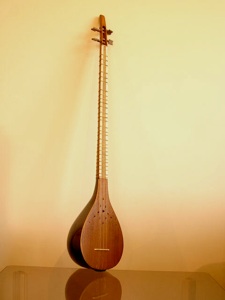Persian traditional classical music similar to Persian miniature painting were originally very much related to the spiritual philosophy of Persian Erfan that Attar, Hafez, Rumi and many others were the pioneers. Learning and practicing the 7 Dastgah( musical systems) or the Radiff ( series of melodies) of the classical persian music could be considered as a musical therapy or kind of meditative experience.
The usual courses consist of two basic musical note books, book I and book II, followed by the Persian modal system (Radif) through traditional and modern methods. This will include the theory and practice learning the Persian 7 Dastgah along with some historical background of Persian classical music. Instruction is one on one basis.
The traditional method of learning these instruments without using the musical notes is called " Hear and Play " method
Workshops may include individual or group rehearsals and instruction; lectures on music appreciation; history of Persian music; music theory; and rhythmic and instrumental explorations.
For the people who are have been victims of 9/11 tragedy or the similar cases who are interested to meditate through the eastern music would be a wonderful experience.
To register for every last Saturday of the month between 2 - 5 PM. please first register as space is limited. Please contact by email:
Instructor: Darab Shabahang
3605 Randolph Rd. Silver Spring, MD 20902
darab@artpars.com
=============================================
About Tar and Setar
SETAR
Setar is a small lute with a long neck, originally with three metallic strings (the present setar
has four strings) that are plucked with the right index finger.
The first representations of the Setar in manuscripts appeared in the sixteenth century. Before this period, long-necked lutes were depicted as resembling the Dotar, whose sound-box and neck are longer.
The origins of the Setar go back the Tanbur of Khorasan described by Farabi in the tenth century. The Setar is just an adaptation of this instrument to which one string was added.
The sound-box of the Setar is curved; like the lute and mandolin, it is generally made of strips of wood. The long and slender neck is attached to the sound-box and the table, which are made of mulberry wood. Three pegs, Gushi, placed at the tip of the neck, two on the right side and two on the left.
TAR
Tar is an Iranian musical instrument developed from another ancient Iranian musical instrument Raba´b. It appeared in its original form at the beginning of the nineteenth century but was modified to its modern form toward the end of the century. The Tar is an exclusively Iranian and very original instrument.
Tar is characterized by its original form, incorporating a sound-box in two unequal parts, called by analogy, naqqare (double kettle drum). Carved out of a mulberry tree, the belly is equipped with a long neck, fitted with camel bone and carrying six strings grouped in pairs.
Old Tar had five strings. It is said that Darvish khan, a master of Persian music in the early 20th century, added one more string. The long fingerboard has twenty-six to twenty-eight adjustable gut frets. Its range is about two and one-half octaves and is played with a brass plectrum, mezeab







